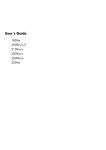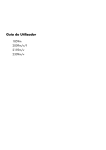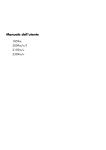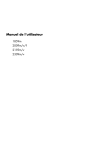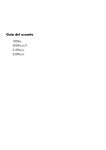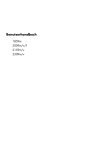Download HP 2009m User's Manual
Transcript
User’s Guide 1859m 2009m/v/f 2159m/v 2309m/v 2709m The only warranties for HP products and services are set forth in the express warranty statements accompanying such products and services. Nothing herein should be construed as constituting an additional warranty. HP shall not be liable for technical or editorial errors or omissions contained herein. HP assumes no responsibility for the use or reliability of its software on equipment that is not furnished by HP. This document contains proprietary information that is protected by copyright. No part of this document may be photocopied, reproduced, or translated to another language without the prior written consent of HP. Hewlett-Packard Company 10955 Tantau Avenue Cupertino, California 95014-0770 USA Copyright © 2006–2010 Hewlett-Packard Development Company, L.P. Microsoft and Windows are U.S. registered trademarks of Microsoft Corporation. Adobe and Acrobat are trademarks of Adobe Systems Incorporated. ENERGY STAR and the ENERGY STAR logo are U.S. registered marks of the United States Environmental Protection Agency. Bluetooth is a trademark owned by its proprietor and used by Hewlett-Packard Company under license. HP supports lawful use of technology and does not endorse or encourage the use of its products for purposes other than those permitted by copyright law. The information contained herein is subject to change without notice. Notational Conventions The following section describes notational conventions used in this document. Notes, Cautions, and Warnings Throughout this guide, blocks of text may be accompanied by an icon. These blocks are notes, cautions, and warnings, and they are used as follows: WARNING: Indicates that failure to follow directions could result in bodily harm or loss of life. CAUTION: Indicates that failure to follow directions could result in damage to equipment or loss of information. NOTE: Indicates additional information. Contents Notational Conventions...................................................................................................................... 1–iii Notes, Cautions, and Warnings..................................................................................................... 1–iii 1 Product Features HP LCD Monitors ................................................................................................................................ 1–1 Features ....................................................................................................................................... 1–1 2 Safety and Maintenance Guidelines Important Safety Information ................................................................................................................ 2–1 Safety Precautions ......................................................................................................................... 2–1 Maintenance Guidelines...................................................................................................................... 2–2 Cleaning the Monitor .......................................................................................................................... 2–2 3 Setting Up the Monitor Unpacking the Monitor........................................................................................................................ 3–1 Installing the Monitor .......................................................................................................................... 3–1 Preparing the monitor for desktop use......................................................................................... 3–1 Preparing the monitor for wall-mounting ...................................................................................... 3–2 Connecting the VGA (Analog) or DVI-D (Digital) Cable ...................................................................... 3–5 To connect the VGA cable......................................................................................................... 3–5 To connect the DVI-D cable........................................................................................................ 3–5 Connecting the HDMI Cable (Select Models Only) ............................................................................ 3–6 Audio and Video Cables and Adapters............................................................................................ 3–6 High-Bandwidth Digital Content Protection (HDCP) ............................................................................ 3–7 Connecting the Audio Cable........................................................................................................... 3–7 Connecting the Power Cable .......................................................................................................... 3–8 Cable Management....................................................................................................................... 3–9 Adjusting the Tilt................................................................................................................................. 3–9 Adjusting the Swivel.......................................................................................................................... 3–10 Keyboard Parking............................................................................................................................. 3–10 4 Operating the Monitor CD Software and Utilities .................................................................................................................... 4–1 Installing Drivers............................................................................................................................ 4–1 Downloading updated drivers from the Internet ............................................................................ 4–1 Using the Auto-Adjustment Function ................................................................................................. 4–2 Front-Panel Controls ............................................................................................................................ 4–3 Using the On-screen Display (OSD) ...................................................................................................... 4–3 OSD Menu Selections .................................................................................................................... 4–4 Selecting Video Input Connectors ......................................................................................................... 4–7 Identifying Monitor Conditions ............................................................................................................. 4–7 Adjusting Screen Quality ..................................................................................................................... 4–8 Optimizing Analog Video .............................................................................................................. 4–8 Power-Saver Feature ........................................................................................................................... 4–8 5 Preparing the Monitor for Shipping Preparing the Monitor for Shipping ................................................................................................. 5–1 A Troubleshooting Solving Common Problems ..................................................................................................................A–1 Getting Support from hp.com ...............................................................................................................A–3 Preparing to Call Technical Support......................................................................................................A–3 Locating the Rating Label................................................................................................................A–3 B Technical Specifications HP LCD Monitors ................................................................................................................................ B–1 Preset Video and High-Definition Modes................................................................................................ B–4 LCD Monitor Quality and Pixel Policy.................................................................................................... B–6 Power Cord Set Requirements .............................................................................................................. B–6 C Agency Regulatory Notices Federal Communications Commission Notice.........................................................................................C–1 Modifications................................................................................................................................C–1 Cables .........................................................................................................................................C–1 Declaration of Conformity for Products Marked with FCC Logo, United States Only ....................................C–1 Materials Disposal ..............................................................................................................................C–2 Chemical Substances ..........................................................................................................................C–2 Canadian Notice ...............................................................................................................................C–2 Avis Canadien ...................................................................................................................................C–2 European Union Regulatory Notice.......................................................................................................C–2 Disposal of Waste Equipment by Users in Private Households in the European Union..................................C–3 Japanese Notice ................................................................................................................................C–3 Japanese Power Cord Notice...............................................................................................................C–3 Japanese Material Content Declaration .................................................................................................C–3 Korean Notice ...................................................................................................................................C–3 EPA ENERGY STAR Compliance ..........................................................................................................C–4 HP Recycling Program.........................................................................................................................C–4 Republic of Turkey EEE Regulation ........................................................................................................C–4 D Index 1 Product Features HP LCD Monitors The HP LCD (liquid crystal display) monitors have an active matrix, thin-film transistor (TFT) screen. This guide discusses the following models: ■ 1859m LCD monitor ■ 2009m/v/f LCD monitor ■ 2159m/v LCD monitor ■ 2309m/v LCD monitor ■ 2709m LCD monitor Features ■ Large diagonal display ■ Optimum resolution: ❏ 1859m: 1366 x 768 @ 60Hz ❏ 2009m/v/f: 1600 x 900 @ 60Hz ❏ 2159m/v: 1920 x 1080 @ 60Hz ❏ 2309m/v: 1920 x 1080 @ 60Hz ❏ 2709m: 1920 x 1080 @ 60Hz Plus full-screen support for lower resolutions ■ Video inputs supported: ❏ VGA analog signal (select models only) ❏ DVI digital signal (select models only) ❏ High-definition multimedia interface (HDMI) (select models only) ■ Fast response time, providing better experience for gaming and graphics ■ Easy viewing from a sitting or standing position, or while moving from one side of the monitor to the other ■ Tilt adjustment ■ Swivel adjustment ■ Removable pedestal and Video Electronics Standards Association (VESA) standard mounting holes for flexible mounting solutions, including wall-mounting ■ Security lock slot for a locking security cable (security cable sold separately) ■ Plug and Play capability, if supported by your computer system ■ On-screen display (OSD) adjustments for ease of setup and screen optimization (choose English, Simplified Chinese, Traditional Chinese, French, German, Italian, Spanish, Dutch, Japanese, or Brazilian Portuguese) ■ Built-in stereo speakers, downward firing ■ Keyboard parking ■ Power Saver to reduce energy consumption ■ Quick View settings display ■ Ambient Light Sensor (select models only) ■ CD included: ❏ Drivers ❏ Auto-adjustment software ❏ Webcam software (select models only) ❏ Documents ❏ Adobe® Acrobat® Reader 2 Safety and Maintenance Guidelines Important Safety Information The power cord is designed for use with your monitor. To use a different cord, use only a power source and connection compatible with this monitor. WARNING: Always connect your monitor, the computer, and other equipment to a grounded (earthed) power outlet. To reduce the risk of electric shock or damage to your equipment, do not disable the power cord grounding feature. The grounding plug is an important safety feature. WARNING: For your safety, be sure that the grounded power outlet you plug the power cord into is easily accessible to the operator and located as close to the equipment as possible. To disconnect power from the equipment, unplug the power cord from the power outlet by grasping the plug firmly. Never pull on the cord. CAUTION: To protect your monitor, as well as your computer, connect all power cords for your computer and its peripheral devices (such as a monitor, printer, or scanner) to a surge protection device such as a power strip with surge protection or uninterruptible power supply (UPS). Not all power strips provide surge protection; the power strips must be specifically labeled as having this ability. Use a power strip whose manufacturer offers a damage replacement policy, so you can replace your equipment if surge protection fails. Safety Precautions ■ Use only a power source and connection compatible with this monitor, as indicated on the label/back plate of the monitor. ■ Be sure the total ampere rating of the products connected to the outlet does not exceed the current rating of the electrical outlet, and the total ampere rating of the products connected to the power cord does not exceed the rating of the power cord. Look on the power label to determine the ampere rating (Amps or A) for each device. ■ Install your monitor near a power outlet that you can easily reach. Disconnect the monitor by grasping the plug firmly and pulling it from the outlet. Never disconnect the monitor by pulling the cord. ■ Do not allow anything to rest on the power cord. Do not walk on the cord. Maintenance Guidelines To enhance the performance and extend the life of your monitor: ■ Do not open your monitor cabinet or attempt to service this product yourself. If your monitor is not operating properly or has been dropped or damaged, contact your Hewlett-Packard authorized dealer, reseller, or service provider. ■ Adjust only those controls that are described in the operating instructions. ■ Turn your monitor off when not in use. You can substantially increase the life expectancy of the monitor by using a screen saver program and turning off the monitor when not in use. ■ Keep your monitor in a well-ventilated area, away from excessive light, heat, or moisture. ■ Slots and openings in the cabinet are provided for ventilation. These openings must not be blocked or covered. Never push objects of any kind into cabinet slots or other openings. ■ Unplug the monitor from the power outlet before cleaning. Do not use liquid cleaners or aerosol cleaners. ■ Do not drop the monitor or place it on an unstable surface. ■ When removing the monitor base, you must lay the monitor face down on a soft area to prevent it from getting scratched, defaced, or broken. Cleaning the Monitor The monitor is a high-quality optical device that requires special care when cleaning. To clean the monitor, follow these steps: 1. Turn off the computer and the monitor. 2. Unplug your monitor from the power outlet before cleaning. CAUTION: Do not use benzene, thinner, ammonia, or any volatile substance to clean the monitor screen or cabinet. These chemicals may damage the monitor. Do not use liquid or aerosol cleaners. Never use water to clean an LCD screen. 3. Wipe the screen with a dry, soft, clean cloth. If the screen requires additional cleaning, use an antistatic screen cleaner. 4. Dust the monitor housing. Use a damp cloth to clean the cabinet. If the cabinet requires additional cleaning, use a clean cloth dampened with isopropyl alcohol. 5. Plug in the monitor. 6. Turn on the monitor and the computer. 3 Setting Up the Monitor Unpacking the Monitor 1. Unpack the monitor. Make sure all contents are included. Store the packing box. 2. Turn off the computer and other attached devices. 3. Determine whether the monitor will be desktop mounted or wall-mounted. See “Installing the Monitor” in this chapter. 4. Prepare a flat area to assemble the monitor. You may need a flat, soft, protected area for placing the monitor screen-down while preparing it for installation. 5. You need a Phillips screwdriver for preparing the monitor for wall-mounting. You may need a straight-slot screwdriver to secure some cables. Installing the Monitor You can install the monitor on a desktop or wall-mount it. Place the monitor in a convenient, well-ventilated location near your computer. Connect the monitor cables after you have installed the monitor. Preparing the monitor for desktop use CAUTION: The screen is fragile. Avoid touching or applying pressure to the LCD screen; doing so can cause damage. Unfold the monitor by lifting it from the top edge of the bezel. 1. Set the monitor screen face down on a flat, soft, protected surface. Unfolding the monitor 2. Grip the base near where it attaches to the monitor with one hand and lift the top part of the monitor until it is unfolded into the desired position. 3. Lift the monitor to an upright position and place on a flat, stable surface. Monitor in upright position Preparing the monitor for wall-mounting WARNING: To reduce the risk of personal injury or of damage to the equipment, check that the wall-mounting fixture is adequately installed and secured before attaching the monitor. Refer to the instructions supplied with the wall-mounting fixture and check that it is capable of supporting the monitor. 1. Disconnect the power cable and any other cables from the monitor. 2. Place the monitor face down on a flat, protected surface. 3. Remove the four screws that fasten monitor base to the monitor. Location of screws securing base to monitor 4. Slide the base away from the bottom of the monitor. Sliding the base away from the monitor 5. Remove the square plate on the back of monitor. Use a coin at the base of the plate to pry it loose. Removing the plate from the back of the monitor Four or six threaded holes are exposed (depending on your model). These holes are for screws to attach the swing arm or other mounting fixture to the back of the monitor. Some models will include mounting screws in the mounting holes. You will need to remove the screws, position the mounting device, then re-install the screws. 100 x 100mm Threaded holes for attaching wall mount 100 x 200mm Threaded holes for attaching wall mount 6. Follow the instructions included with the mounting fixture to ensure that the monitor is safely attached. The threaded holes that are on the back of the panel are compliant with the VESA standard for mounting flat-panel monitors. 7. Attach a swing arm or other mounting fixture. Connecting the VGA (Analog) or DVI-D (Digital) Cable Use a VGA video cable or a DVI-D video cable (provided with select models). To use DVI, you must have a DVI-compliant graphic card. Connectors are located on the back of the monitor. Be sure the computer and monitor are turned off and unplugged. Some graphic cards have both a DVI connector and a DVI-to-VGA converter included in the box (select models only). If the monitor has a VGA connector but no DVI connector, use the DVI-to-VGA converter to connect to the computer: Connect the DVI-to-VGA converter to the DVI connector on the computer graphic card, and then connect the VGA cable to the converter and the monitor. Connecting the VGA or DVI-D cable—connector locations may vary To connect the VGA cable Connect one end of the VGA video cable to the back of the monitor and the other end to the VGA video connector on the computer. To connect the DVI-D cable Connect one end of the DVI-D video cable to the back of the monitor and the other end to the DVI video connector on the computer. You can use this cable only if your computer has a DVI-compliant graphic card installed. The monitor DVI-D connector and cable are included with select models only. NOTE: If you use a DVI-to-HDMI adapter, you must connect the green audio cable to enable the speakers. The signal from the DVI connector is for video only. Connecting the HDMI Cable (Select Models Only) Connect one end of the HDMI cable to the back of the monitor and the other end to a computer with an HDMI connector. Audio and Video Cables and Adapters The following table shows the cable and adapter types that may be required to connect the monitor to the computer, TV, or set-top box. The number and type of cables required may vary by model. Some cables and adapters are included for select models only and may be sold separately. Cable/Adapter Name Description HDMI cable HDMI transmits an all-digital signal. It is the recommended choice for playback from a DVD or DVR. HDMI is capable of transmitting both uncompressed digital audio and digital video signals, because it has video, audio, and control signals. DVI cable DVI transmits an all-digital video signal. VGA cable VGA transmits an analog video signal. DVI-to-VGA adapter Connects a DVI monitor to a VGA connector on the back of the computer, TV, or set-top box or connects a VGA monitor to a DVI connector on the back of the computer, TV, or set-top box. Cable/Adapter (Continued) Name Description DVI-to-HDMI adapter Connects a DVI monitor to an HDMI connector on the back of the computer, TV, or set-top box or connects an HDMI monitor to a DVI connector on the back of the computer, TV, or set-top box. NOTE: If you use a DVI-to-HDMI adapter, you must connect the green audio cable to enable the speakers. VGA-to-DVI-I cable Connects a DVI monitor to a VGA connector on the back of the computer, TV, or set-top box or connects a VGA monitor to a DVI connector on the back of the computer, TV, or set-top box. NOTE: When using a VGA or DVI signal, you must connect your audio separately because a VGA or DVI signal converts only video data, not audio data. A separate audio connection is not necessary when you use an HDMI signal, because an HDMI signal can convert both video and audio data. High-Bandwidth Digital Content Protection (HDCP) If your monitor supports HDCP, it can receive high-definition content. High-definition content is available in many sources, such as Blu-ray Disc devices or HDTV air or cable broadcasts. If you do not have an HDCP-enabled monitor, you may see a black screen or a lower resolution picture when playing high-definition protected content. Your computer graphic card and monitor must both support HDCP to display protected content. Connecting the Audio Cable Connect the built-in monitor speakers to the computer by using the audio cable, as shown in the following illustration. Connecting the audio cables—connector locations may vary Connecting the Power Cable 1. Read the warning below. WARNING: To reduce the risk of electric shock or damage to your equipment: ■ Do not disable the power cord grounding plug. The grounding plug is an important safety feature. Plug the power cord into a grounded (earthed) electrical outlet. ■ Be sure that the grounded power outlet you plug the power cord into is easily accessible to the operator and located as close to the equipment as possible. A power cord should be routed so that it is not likely to be walked on or pinched by items that are placed upon it or against it. ■ Do not place anything on power cords or cables. Arrange them so that no one may accidentally step on or trip over them. Do not pull on a cord or cable. See “Technical Specifications” (Appendix B) for additional information. Connecting the power cable 2. Connect one end of the power cable to the monitor and the other end to a grounded electrical outlet. Cable Management The HP LCD monitors have cable management. Cables can be easily routed through the square hole in the base and are partially hidden when viewed from the front. . Adjusting the Tilt For optimal viewing, adjust the screen tilt to your own preference, as follows: 1. Face the front of the monitor and hold the base so that you do not topple the monitor while changing the tilt. 2. Adjust the tilt by moving the top edge of the monitor either toward or away from you, without touching the screen. Adjusting the Swivel The HP LCD monitor allows a usable range of motion with the swivel feature. CAUTION: To avoid breakage or other damage, avoid applying pressure to the LCD screen while swiveling it or changing the tilt. Keyboard Parking If you need more space on your desktop, place the keyboard under the monitor when not in use. 4 Operating the Monitor CD Software and Utilities The CD that is included with this monitor contains the drivers and software that you can install on your computer. Installing Drivers If you determine that you need to update the drivers, you can install the monitor-driver INF and ICM files from the CD, or download them from the Internet. To install the monitor-driver software from the CD: 1. Insert the CD in your computer CD drive. The CD menu appears. 2. Select the language. 3. Click Install Monitor Driver Software. 4. Follow the onscreen instructions. 5. Restart the computer. 6. Ensure that the proper resolutions and refresh rates appear in the Display Control Panel settings. Refer to the Windows® operating system documentation for more information. NOTE: You might need to install the digitally signed monitor drivers (INF or ICM files) manually from the CD, in case of an installation error. Refer to the “Driver Software Readme” file on the CD for instructions (in English only). Downloading updated drivers from the Internet To download the latest version of drivers and software files from the HP Support site: 1. Refer to: http://www.hp.com/support 2. Select your country/region. 3. Select Download Drivers and Software. 4. Enter the model number of your monitor. The software-download pages for your monitor are displayed. 5. Download and install the driver and software files by using the instructions in the download pages. 6. Ensure that your system meets the requirements. Using the Auto-Adjustment Function You can easily optimize the screen performance for the VGA input by using the Auto/Select button on the monitor and the auto-adjustment pattern software on the CD provided. Do not use this procedure if your monitor is using a DVI or HDMI input. If your monitor is using the VGA input, this procedure can correct the following image-quality conditions: ■ Fuzzy or unclear focus ■ Ghosting, streaking, or shadowing effects ■ Faint vertical bars ■ Thin, horizontal scrolling lines ■ Off-center picture CAUTION: Burn-in image damage may occur on monitors that display the same static image on screen for a prolonged period of time (12 consecutive hours of non-use). To avoid burn-in image damage on your monitor screen, you should always activate a screen saver application or turn off the monitor when it is not in use for a prolonged period of time. Image retention is a condition that may occur on all LCD screens. To use the auto-adjustment feature: 1. Allow the monitor to warm up for 20 minutes before adjusting. 2. Press the Auto/Select button on the monitor front panel. 3. ❏ You can also press the Menu button, and then select Image Control, followed by Auto Adjustment from the OSD menu. See “Adjusting Screen Quality” in this chapter. ❏ If the result is not satisfactory, continue with the procedure. Insert the CD in your computer CD drive. The CD menu displays. 4. Select the language. 5. Select Open Auto-Adjustment Software. 6. The setup test pattern displays. Auto-adjustment setup test pattern 7. Press the Auto/Select button on the monitor front panel to produce a stable, centered image. Front-Panel Controls Control buttons are located on the lower right front of the monitor: Icon Description Power Turns the monitor on and to standby or sleep mode. NOTE: The power button is located on the top or front of the monitor depending on the model. Menu Opens, selects, or exits the OSD menu. Adjusts the volume level. Source Chooses video input source from the computer. – Navigates backward through the OSD menu and decreases adjustment levels. + Navigates forward through the OSD menu and increases adjustment levels. Auto OK Auto-adjusts the display to the ideal setting when the OSD is not active. Enters the selected option. Using the On-screen Display (OSD) An On-screen display is an image superimposed on a screen picture, commonly used by monitors, televisions, VCRs, and DVD players to display information such as volume, channel, and time. NOTE: You can use My Display OSD software or the front-panel control buttons to adjust settings. 1. If the monitor is not already on, press the Power button to turn on the monitor. 2. To access the OSD menu, press the Menu button. The OSD Main Menu displays. 3. To navigate through the Main or Sub-Menu menu, press the + (Plus) button on the monitor’s front panel to scroll up, or the – (Minus) button to scroll in reverse. Then press the Auto/Select button to select the highlighted function. The menu moves to the top if you scroll down at the bottom of the selections. The menu moves to the bottom if you scroll up at the top of the selections. 4. To adjust the scale of a selected item, press the + or – button. 5. Select Save and Return. If you don’t want to save the setting, select Cancel from the Sub-Menu or Exit from the Main Menu. 6. Press the Menu button to exit the OSD. NOTE: When a menu is displayed, if the buttons are untouched for 30 seconds (factory default), adjustments and settings are saved and the menu closes. OSD Menu Selections The following table lists the On-Screen Display (OSD) menu selections and their functional descriptions. After changing an OSD menu item, and if the menu screen has these options, you may choose to: ■ Cancel — to return to the previous menu level. ■ Save and Return — to save all changes and return to the OSD Main Menu screen. This Save and Return option is active only if you change a menu item. ■ Reset — to change back to the previous setting. Icon Main Menu Options Submenu Options Description Switch Video Input (select models only) Switches the video input signal source when the monitor is connected to two active and valid video sources. Switching video input sources may take several seconds. Brightness Adjusts the brightness level of the screen. Contrast Adjusts the contrast level of the screen. Image Control Adjusts the screen image. Also enables or disables the ambient light sensor (select models). Auto-Adjustment Automatically adjusts the screen image (VGA Input only). Horizontal Position Adjusts the horizontal position of the picture (VGA Input only). Vertical Position Adjusts the vertical position of the picture (VGA Input only). Clock Minimizes any vertical bars or strips visible on the screen background. Adjusting the clock will also change the horizontal screen image (VGA Input only). Clock Phase Adjusts the focus of the display. This adjustment allows you to remove any horizontal noise, and clear or sharpen the image of characters (VGA Input only). Color Selects the screen color. The factory default is 6500 K or Custom Color, depending on the model. 9300 K Changes to slightly blueish white. 6500 K Changes to slightly reddish white. Custom Color Selects and adjusts your own color scales: R — Sets your own red color levels. G — Sets your own green color levels. B — Sets your own blue color levels. sRGB Language Sets your screen colors to adapt to the color standards used in the image technology industry. Selects the language in which the OSD menu is displayed. The factory default is English. Icon Main Menu Options Submenu Options Management Description (Continued) Selects the power-management features of the monitor. Volume Adjusts the volume level. OSD Control Adjusts the position of the OSD menu on the screen. Horizontal OSD Position — Changes the viewing position of the OSD menu to the left or right area of the screen. The factory default range is 50. Vertical OSD Position — Changes the viewing position of the OSD menu to the top or bottom area of the screen. The factory default range is 50. OSD Transparency — Adjust to view the background information through the OSD. OSD Timeout — Sets the time in seconds that the OSD is visible after the last button is pressed. The factory default is 30 seconds. Power Saver Enables the power saving feature (see “Power-Saver Feature” in this chapter). Select: On Off The factory default is On. Mode Display Displays the resolution, refresh rate, and frequency information on the screen each time the OSD Main Menu is accessed. Select: On Off The factory default is On or Off, depending on the model. Power-On Status Display Displays the operating status of the monitor each time the monitor is powered on. Select the location to which to display the status: Top Middle Bottom Off The factory default is Top or Off, depending on the model. DDC/CI Support Allows the computer to control some OSD menu features such as brightness, contrast, and color temperature. Set to: On Off The factory default is On. Bezel Power LED Turns the light (LED) in the power button On and Off. When set to Off, the light will remain off at all times. Icon Main Menu Options Management (continued) Submenu Options Description (Continued) Sleep Timer Provides the timer-adjustment menu options: Set Current Time — Sets the current time in hours and minutes. Set Sleep Time — Sets the time you want to place the monitor in sleep mode. Set on Time — Sets the time you want the monitor to wake up from sleep mode. Timer — Sets the Sleep Timer feature On or Off; the default setting is Off. Sleep Now — Immediately sets the monitor to enter sleep mode. Default Video Input Information Factory Reset Selects the default video input signal when the monitor is connected to two active and valid video sources. The default is DVI. You must restart the computer to have the change take effect. Selects and displays important information about the monitor. Current Settings Provides the current input video mode. Recommended Settings Provides the recommended resolution mode and refresh rate for the monitor. Serial Number Reports the serial number of the monitor. The serial number is needed if contacting HP technical support. Version Reports the firmware version of the monitor. Backlight Hours Reports the total hours of backlight operation. Service Support For service support, go to: http://www.hp.com/support Returns settings to factory defaults. Selecting Video Input Connectors The input connectors are: ■ VGA connector (analog) ■ DVI-D connector (digital) ■ HDMI connector The monitor automatically determines which inputs have valid video signals, and displays the image. You can connect the VGA cable, the DVI-D cable, or both. If both cables are installed, the default input selection is DVI. The HDMI cable is in place of the DVI-D cable. The source of input can be switched using the Switch Video Input option in the OSD menu. Switching from a VGA to an HDMI input source may take several seconds. Identifying Monitor Conditions Special messages appear on the monitor screen for the following monitor conditions: ■ Input Signal Out of Range — Indicates the monitor does not support the video card’s input signal because its resolution or refresh rate are set higher than the monitor supports. Change your video card settings to a lower resolution or refresh rate. Restart your computer for the new settings to take effect. ■ Monitor Going to Sleep — Indicates the screen display is entering a sleep mode. The speakers are turned off in sleep mode. ■ Check Video Cable — Indicates a video input cable is not properly connected to the computer or monitor. ■ OSD Lock-out — The OSD can be enabled or disabled by pressing and holding the Menu button on the front panel for 10 seconds. If the OSD is locked, the warning message OSD Lock-out appears for 10 seconds. If the OSD is locked, press and hold the Menu button for 10 seconds to unlock the OSD. If the OSD is unlocked, press and hold the Menu button for 10 seconds to lock the OSD. ■ No Input Signal — Indicates the monitor is not receiving a video signal from the computer on the monitor video input connector(s). Check to see if the computer or input signal source is off or in the power-saver mode. ■ Auto Adjustment in Progress — Indicates the auto-adjustment function is active. See “Adjusting Screen Quality” in this chapter. Adjusting Screen Quality The auto-adjustment feature automatically fine-tunes the image quality for display size, position, clock, and phase each time a new video mode is displayed. For more precise adjustments of VGA input, run the Auto-Adjustment software on the CD. See “Using the Auto-Adjustment Function” in this chapter. If you want additional image-quality improvement, use the Clock and Clock Phase controls of the monitor to fine-tune the image. See “Optimizing Analog Video” in this chapter. Optimizing Analog Video Some monitors contain advanced circuitry that allow the monitor to function as a standard analog monitor. Two controls in the OSD menu can be adjusted to improve analog image performance: ■ Clock — Increase or decrease the value to minimize any vertical bars or stripes visible on the screen background. ■ Clock Phase — Increase or decrease the value to minimize video distortion or video jitter. Use these controls only when the auto-adjustment function does not provide a satisfactory monitor image in analog mode. To obtain the best results: 1. Allow the monitor to warm up for 20 minutes before adjusting. 2. Display the adjustment-pattern application provided on the CD. 3. Access the OSD menu, then select Image Control. 4. Set the main Clock settings correctly first, because the Clock Phase settings depend on the main Clock setting. When adjusting the Clock and Clock Phase values, if the monitor images become distorted, continue adjusting the values until the distortion disappears. To restore the factory settings, access the OSD menu, select Factory Reset, and then select Yes. Power-Saver Feature When the monitor is in normal operating mode, the Power light is green and the monitor uses the normal watts of power. For power usage, refer to “Technical Specifications” (Appendix B). The monitor also supports a power-saver mode that is controlled by the computer. When the monitor is in the reduced-power state, the monitor screen is blank, the backlight is off, and the Power light is amber. The monitor uses minimum power. When the monitor is “awakened,” a brief warm-up period occurs before the monitor returns to normal operating mode. The energy-saving reduced power state activates if the monitor does not detect either the horizontal sync signal or the vertical sync signal. The power-saver feature must be activated on your computer for this feature to work. Refer to your computer documentation for instructions on setting energy-saver features (sometimes called power-management features). NOTE: The energy-saver feature works only when the monitor is connected to computers that have energy-saver features. 5 Preparing the Monitor for Shipping Keep the original packing box in a storage area. You may need it later if you move or ship your monitor. WARNING: Before folding the monitor, turn off the monitor power, and disconnect all power, video, and audio cables. To disconnect power from the equipment, unplug the power cord from the power outlet by grasping the power plug firmly. Never pull on the cord. CAUTION: The screen is fragile. Placing the monitor screen down on a flat, soft area prevents scratches, defacing, or breakage. Avoid applying pressure to the LCD screen; doing so can cause damage. Preparing the Monitor for Shipping 1. Disconnect the power, video, and audio cables from the monitor. 2. Set the monitor base on a soft, protected surface. Preparing the monitor for shipping 3. Hold the base with one hand, where it attaches to the rear of the monitor, and push the monitor forward, folding the monitor flat onto the soft, protected surface. 4. Place the monitor and base in the original packing box. A Troubleshooting Solving Common Problems The following table lists possible problems, the possible cause of each problem, and the recommended solutions: Problem Solution Power LED is not on. Make sure the Power button is on, and the power cord is properly connected to a grounded power outlet and to the monitor. Select Management in the OSD menu, and then select Bezel Power LED. Check if the Bezel Power LED option is set to Off and, if so, set to On mode. Screen is blank. Connect the power cord. Turn on the power. Connect the video cable properly. See “Setting Up the Monitor” for more information. Press a key on the keyboard or move the mouse to turn off the screen-blanking utility. Screen is black or displaying at a lower resolution while displaying high-definition (HD) content. Check if your monitor and computer support HDCP. Image appears blurred, indistinct, or too dark. Press the Auto/Select button on the monitor front panel. If this does not correct the image, press the Menu button to open the OSD menu, and adjust the brightness and contrast scales. Image is not centered. Press the Menu button to access the OSD menu. Select Image Control, and then select Horizontal Position or Vertical Position to adjust the position of the image. Check Video Cable appears on screen. Connect the monitor VGA signal cable to the VGA connector on the computer, or connect the DVI-D signal cable to the DVI connector on the computer. Be sure that the computer power is off while connecting the video cable. Input Signal Out of Range appears on screen. Restart your computer and enter Safe Mode. Change your settings to a supported setting (see the table in “Preset Video and High-Definition Modes” in Appendix B). Restart your computer so that the new settings take effect. Picture is fuzzy and has ghosting, shadowing problem. Adjust the contrast and brightness controls. Refer to High-Content Digital Bandwidth Protection or http://www.hp.com/support Make sure that you are not using an extension cable or switch box. We recommend plugging the monitor directly into the graphic card output connector on the back of your computer. For VGA input, the auto-adjustment feature might fix this problem. Unable to set the monitor to the optimal resolution. Make sure the graphic card supports the optimal resolution. Using HDMI connection, unable to hear audio. Ensure HDMI audio is selected as the main audio output in the operating system. To do so, click the Windows Start Button, and then click Control Panel. Click Sound, and in the Playback tab, ensure the check mark is next to the HDMI output, and click OK. Make sure the latest supported driver is installed for the graphic card. For HP and Compaq systems, you can download the latest graphics driver for your system from: www.hp.com/support. For other systems, refer to the Web site for your graphic card. Problem Solution (Continued) Unable to hear audio from built-in speakers. Do the following: ■ ■ ■ ■ No Plug and Play. Ensure the source signal is good by using headphones at the source. Press the Menu button to access the OSD menu. Select Management, and then select Volume to adjust the volume. Turn up the volume with the front panel volume button. Ensure speaker volume is not muted or too low: Click the Windows Start Button, Control Panel, and Hardware and Sound. Under Audio Devices and Sound, click Adjust system volume. Under Main Volume, move the slider up. In order for the Plug and Play feature of the monitor to work, you need a computer and graphic card that are compatible with Plug and Play. Check with your computer manufacturer. Check the monitor’s video cable, and make sure that none of the pins are bent. Make sure that the HP monitor drivers are installed. Refer to “Installing Drivers” in the Operating the Monitor chapter for more information. HP monitor drivers are also available at: http://www.hp.com/support Picture bounces, flickers, or wave pattern is present in the picture. Move electrical devices that may cause electrical interference as far away from the monitor as possible. Monitor is always in “Sleep Mode (Amber LED).” The computer power switch should be in the On position. Use the maximum refresh rate that your monitor is capable of at the resolution that you are using. The computer graphic card should be snugly seated in its slot. Check that the monitor video cable is properly connected to the computer. Inspect the monitor video cable, and make sure that none of the pins are bent. Check that your computer is operational: Press the Caps Lock key and observe the Caps Lock LED found on most keyboards. The LED should either turn on or off after hitting the Caps Lock key. Getting Support from hp.com Before you contact customer service, refer to HP Technical Support at: http://www.hp.com/support Select your country/region, and then follow the links to the support page for your monitor. Preparing to Call Technical Support If you cannot solve a problem by using the troubleshooting tips in this section, you might have to call technical support. For technical support contact information, refer to the printed documentation included with the monitor. Have the following information available when you call: ■ Monitor model number (located on label on back of monitor) ■ Monitor serial number (located on label on back of monitor or in the OSD display in the Information menu) ■ Purchase date on invoice ■ Conditions under which the problem occurred ■ Error messages received ■ Hardware configuration ■ Name and version of hardware and software you are using Locating the Rating Label The rating label on the monitor provides the product number and serial number. You may need these numbers when contacting HP about your monitor model. The rating label is on the back of the monitor. B Technical Specifications All specifications represent the typical specifications provided by HP’s component manufacturers; actual performance may vary either higher or lower. HP LCD Monitors Face treatment: Glare polarizer with hard coating Input Terminals: ■ VGA connector (select models) ■ DVI-D 24-pin D-type connector (select models) ■ HDMI connector (select models) Specifications model 1859m Display Type: TFT LCD active matrix Viewable Image Size: 18.5 in. (47.0 cm) diagonal Tilt: –5o to +25o Maximum Weight (unpacked): 9.5 lb (4.3 kg) Dimensions (h x w x d): 14.0 x 18.0 x 7.2 in. (355 x 470 x 184 mm) Maximum Graphics Resolution: 1366 x 768 @ 60 Hz analog mode Optimum Graphics Resolution: 1366 x 768 @ 60 Hz analog mode Text Mode: 720 x 400 Dot Pitch: 0.30 x 0.30 mm Horizontal Frequency (analog mode): 24 to 83 kHz Vertical Frequency (analog mode): 50 to 76 Hz Environmental Requirements Temperature (independent of altitude) Operating Temperature: 41o to 104o F (5o to 40o C) Non-operating Temperature: –29o to 140o F (–20o to 60o C) Relative Humidity (non-condensing): Operating Humidity: 20% to 80% Non-operating Humidity: 5% to 95% Power Source: 100–240Vv, 50/60 Hz Power Consumption: 40 watts maximum Sleep Power Consumption: <2 watts typical Specifications (Continued) model 2009m/v/f Display Type: TFT LCD active matrix Viewable Image Size: 20 in. (50.8 cm) diagonal Tilt: –5o to +25o Dimensions (h x w x d): 18.9 x 20.6 x 11.4 in. (481 x 523 x 289 mm) Maximum Graphics Resolution: 1600 x 900 @ 60 Hz analog mode Optimum Graphics Resolution: 1600 x 900 @ 60 Hz analog mode Text Mode: 720 x 400 Dot Pitch: 0.2768 x 0.2768 mm Horizontal Frequency (analog mode): 24 to 85 kHz Vertical Frequency (analog mode): 48 to 76 Hz Environmental Requirements Temperature (independent of altitude) Operating Temperature: 41o to 104o F (5o to 40o C) Non-operating Temperature: –29o to 140o F (–20o to 60o C) Relative Humidity (non-condensing): Operating Humidity: 20% to 80% Non-operating Humidity: 5% to 95% Power Source: 100–240Vv, 50/60 Hz Power Consumption: 56 watts maximum Sleep Power Consumption: <2 watts typical model 2159m/v Display Type: TFT LCD active matrix Viewable Image Size: 21.53 in. (55.68 cm) diagonal Tilt: –5o to +25o Maximum Weight (unpacked): 13.2 lb (6.0 kg) Dimensions (h x w x d): 16.3 x 22.2 x 7.6 in. (415 x 563 x 194 mm) Maximum Graphics Resolution: 1920 x 1080 @ 60 Hz analog mode Optimum Graphics Resolution: 1920 x 1080 @ 60 Hz analog mode Text Mode: 720 x 400 Dot Pitch: 0.2480 x 0.2480 mm Horizontal Frequency (analog mode): 24 to 94 kHz Vertical Frequency (analog mode): 50 to 76 Hz Environmental Requirements Temperature (independent of altitude) Operating Temperature: 41o to 104o F (5o to 40o C) Non-operating Temperature: –29o to 140o F (–20o to 60o C) Relative Humidity (non-condensing): Operating Humidity: 20% to 80% Non-operating Humidity: 5% to 95% Power Source: 100–240Vv, 50/60 Hz Power Consumption: 56 watts maximum Sleep Power Consumption: <2 watts typical Specifications (Continued) model 2309m/v Display Type: TFT LCD active matrix Viewable Image Size: 23.0 in. (58.42 cm) diagonal Tilt: –5o to +25o Maximum Weight (unpacked): 21.6 lb (9.8 kg) Dimensions (h x w x d) 16.2 x 22.6 x 7.9 in. (412 x 573 x 200 mm) Maximum Graphics Resolution: 1920 x 1080 @ 60 Hz analog mode Optimum Graphics Resolution: 1920 x 1080 @ 60 Hz analog mode Text Mode: 720 x 400 Dot Pitch: 0.265 x 0.265 mm Horizontal Frequency (analog mode): 24 to 94 kHz Vertical Frequency (analog mode): 50 to 76 Hz Environmental Requirements Temperature (independent of altitude) Operating Temperature: 41o to 104o F (5o to 40o C) Non-operating Temperature: –29o to 140o F (–20o to 60o C) Relative Humidity (non-condensing): Operating Humidity: 20% to 80% Non-operating Humidity: 5% to 95% Power Source: 100–240Vv, 50/60 Hz Power Consumption: 54 watts maximum Sleep Power Consumption: <2 watts typical model 2709m Display Type: TFT LCD active matrix Viewable Image Size: 27 in. (68.58 cm) diagonal Tilt: –5o to +25o Maximum Weight (unpacked): 21.2 lb (9.6 kg) Dimensions (h x w x d): 18.5 x 26.4 x 8.4 in. (469 x 671 x 214 mm) Maximum Graphics Resolution: 1920 x 1080 @ 60 Hz analog mode Optimum Graphics Resolution: 1920 x 1080 @ 60 Hz analog mode Text Mode: 720 x 400 Dot Pitch: 0.265 x 0.265 mm Horizontal Frequency (analog mode): 24 to 94 kHz Vertical Frequency (analog mode): 48 to 76 Hz Environmental Requirements Temperature (independent of altitude) Operating Temperature: 41o to 104o F (5o to 40o C) Non-operating Temperature: –29o to 140o F (–20o to 60o C) Relative Humidity (non-condensing): Operating Humidity: 20% to 80% Non-operating Humidity: 5% to 95% Power Source: 100–240Vv, 50/60 Hz Power Consumption: 120 watts maximum Sleep Power Consumption: <2 watts typical Preset Video and High-Definition Modes The monitor automatically recognizes many preset video input modes that will appear properly sized and centered on the screen. Factory Preset Video Input Modes, 1859m Preset Resolution Horizontal Frequency (kHz) Vertical Frequency (Hz) 1 640 x 480 31.47 59.94 2 720 x 400 31.47 70.09 3 800 x 600 37.88 60.32 4 1024 x 768 48.36 60.00 5 1280 x 960 60.00 60.00 6 1280 x 1024 63.98 60.02 7 1366 x 768 47.71 59.79 Factory Preset Video Input Modes, 2009m/v/f Preset Resolution Horizontal Frequency (kHz) Vertical Frequency (Hz) 1 640 x 480 31.47 59.94 2 720 x 400 31.47 70.09 3 800 x 600 37.88 60.32 4 1024 x 768 48.36 60.00 5 1280 x 1024 63.98 60.02 6 1440 x 900 55.93 59.88 7 1600 x 900 55.54 59.98 Factory Preset Video Input Modes, 2159m/v, 2309m/v, and 2709m Preset Resolution Horizontal Frequency (kHz) Vertical Frequency (Hz) 1 640 x 480 31.47 59.94 2 720 x 400 31.47 70.09 3 800 x 600 37.88 60.32 4 1024 x 768 48.36 60.00 5 1280 x 960 60.00 60.00 6 1280 x 1024 63.98 60.02 7 1440 x 900 55.93 59.88 8 1600 x 1200 75.00 60.00 9 1680 x 1050 65.29 60.00 10 1920 x 1080 67.50 60.00 High Definition Video Formats Preset Timing Name Resolution Horizontal Frequency (kHz) Vertical Frequency (Hz) 1 480i 720 x 480 15.73 60 2 480p 720 x 480 31.47 60 3 720p60 1280 x 720 45.00 60 4 1080i60 1920 x 1080 33.75 60 5 576i 720 x 576 15.63 50 6 576p 720 x 576 31.25 50 7 720p60 1280 x 1920 37.50 50 8 1080i50 1920 x 1080 28.13 50 9 1080p60 1920 x 1080 67.50 60 10 1080p50 1920 x 1080 56.25 50 LCD Monitor Quality and Pixel Policy The HP LCD Monitor uses high-precision technology, manufactured according to high standards, to help guarantee trouble-free performance. Nevertheless, the display may have cosmetic imperfections that appear as small bright or dark spots. This is common to all LCD displays used in products supplied by all vendors and is not specific to the HP LCD Monitor. These imperfections are caused by one or more defective pixels or subpixels. ■ A pixel consists of one red, one green, and one blue subpixel. ■ A defective whole pixel is always turned on (a bright spot on a dark background), or it is always off (a dark spot on a bright background). The first is the more visible of the two. ■ A defective subpixel (dot defect) is less visible than a defective whole pixel, and is small and only visible on a specific background. To locate defective pixels, the monitor should be viewed under normal operating conditions and in normal operating mode at a supported resolution and refresh rate, from a distance of approximately 16 inches (50 cm). We expect that, over time, the industry will continue to improve its ability to produce displays with fewer cosmetic imperfections, and we will adjust guidelines as improvements are made. For more information about your HP LCD Monitor, refer to the HP Web site at: http://www.hp.com/support Power Cord Set Requirements The monitor power supply is provided with Automatic Line Switching (ALS). This feature allows the monitor to operate on input voltages between 100–240Vv, 50/60 Hz, 1.5A. The power cord set (flexible cord or wall plug) received with the monitor meets the requirements for use in the country/region where you purchased the equipment. If you need to obtain a power cord for a different country/region, you should purchase a power cord that is approved for use in that country/region. The power cord must be rated for the product and for the voltage and current marked on the product’s electrical ratings label. The voltage and current rating of the cord should be greater than the voltage and current rating marked on the product. If you have questions about the type of power cord to use, contact your HP-authorized service provider. A power cord should be routed so that it is not likely to be walked on or pinched by items placed upon it or against it. Particular attention should be paid to the plug, electrical outlet, and the point where the cord exits from the product. C Agency Regulatory Notices Federal Communications Commission Notice This equipment has been tested and found to comply with the limits for a Class B digital device, pursuant to Part 15 of the FCC Rules. These limits are designed to provide reasonable protection against harmful interference in a residential installation. This equipment generates, uses, and can radiate radio frequency energy and, if not installed and used in accordance with the instructions, may cause harmful interference to radio communications. However, there is no guarantee that interference will not occur in a particular installation. If this equipment does cause harmful interference to radio or television reception, which can be determined by turning the equipment off and on, the user is encouraged to try to correct the interference by one or more of the following measures: ■ Reorient or relocate the receiving antenna. ■ Increase the separation between the equipment and the receiver. ■ Connect the equipment into an outlet on a circuit different from that to which the receiver is connected. ■ Consult the dealer or an experienced radio or television technician for help. Modifications The FCC requires the user to be notified that any changes or modifications made to this device that are not expressly approved by Hewlett-Packard Company may void the user’s authority to operate the equipment. Cables Connections to this device must be made with shielded cables with metallic RFI/EMI connector hoods to maintain compliance with FCC rules and regulations. Declaration of Conformity for Products Marked with FCC Logo, United States Only This device complies with Part 15 of the FCC Rules. Operation is subject to the following two conditions: (1) this device may not cause harmful interference, and (2) this device must accept any interference received, including interference that may cause undesired operation. For questions regarding your product, contact: Hewlett-Packard Company P. O. Box 692000, Mail Stop 530113 Houston, Texas 77269-2000 Or Call: 1-800-474-6836 For questions regarding this FCC declaration, contact: Hewlett-Packard Company P. O. Box 692000, Mail Stop 510101 Houston, Texas 77269-2000 Or Call: 1-281-514-3333 To identify this product, refer to the part, series, or model number found on the product. Materials Disposal This HP product contains mercury in the fluorescent lamp in the display LCD that might require special handling at end-of-life: Disposal of this material can be regulated because of environmental considerations. For disposal or recycling information, contact your local authorities or the Electronic Industries Alliance (EIA) (http://www.eiae.org). Chemical Substances HP is committed to providing our customers with information about the chemical substances in our products as needed to comply with legal requirements such as REACH (Regulation EC No 1907/2006 of the European Parliament and the Council). A chemical information report for this product can be found at: http://www.hp.com/go/reach Canadian Notice This Class B digital apparatus meets all requirements of the Canadian Interference-Causing Equipment Regulations. Avis Canadien Cet appareil numérique de la classe B respecte toutes les exigences du Règlement sur le matériel brouilleur du Canada. European Union Regulatory Notice Products bearing the CD marking comply with the following EU Directives: ■ Low Voltage Directive 2006/95/EC ■ EMC Directive 2004/108/EC ■ Ecodesign Directive 2009/125/EC, where applicable CE Compliance of this product is valid if powered with the correct CE-marked AC adapter provided by HP. Compliance with these directives implies conformity to applicable harmonized European standards (European Norms) that are listed on the EU Declaration of Conformity issued by Hewlett-Packard for this product or product family and available (in English only) either within the product documentation or at the following web site: http://www.hp.ed/certificates (type the product number in the search field). This compliance is indicated by one of the following conformity markings placed on the product: For non-telecommunications products and for EU harmonized telecommunications products, such as Bluetooth® within power class below 10mW. For EU non-harmonized telecommunications products (if applicable, a 4-digit notified body number is inserted between CE and !). Please refer to the regulatory label provided on the product. The point of contact for regulatory matters is: Hewlett-Packard GmbH, HQ-TRE, Herrenberger Straße 140, 71034 Böblingen, Germany. Disposal of Waste Equipment by Users in Private Households in the European Union This symbol on the product or on its packaging indicates that this product must not be disposed of with your other household waste. Instead, it is your responsibility to dispose of your waste equipment by handing it over to a designated collection point for the recycling of waste electrical and electronic equipment. The separate collection and recycling of your waste equipment at the time of disposal will help to conserve natural resources and ensure that it is recycled in a manner that protects human health and the environment. For more information about where you can drop off your waste equipment for recycling, please contact your local city office, your household waste disposal service or the shop where you purchased the product. Japanese Notice Japanese Power Cord Notice Japanese Material Content Declaration A Japanese regulatory requirement, defined by Specification JIS-C-0950, 2008, mandates that manufacturers provide Material Content Declarations for certain categories of electronic products offered for sale after July 1, 2006. To view the JIS-C-0950 material declaration for this product, visit www.hp.com/go/jisc0950 Korean Notice EPA ENERGY STAR Compliance Products marked with the ENERGY STAR® logo on the packaging box qualify with the U.S. Environmental Protection Agency’s ENERGY STAR® guidelines for energy efficiency. Products with the ENERGY STAR® label are designed to use less energy, help you save money on utility bills, and help protect the environment. ENERGY STAR® is a registered trademark owned by the U.S. government. HP Recycling Program HP offers product end-of-life return programs for HP and other manufacturers’ hardware in several geographic areas. The terms and availability of these programs vary by geography because of differences in regulatory requirements and local customer demand. For information on the HP recycling program, refer to the HP Web site at: http://www.hp.com/recycle Republic of Turkey EEE Regulation Republic of Turkey: In conformity with the EEE Regulation. The Table of Toxic and Hazardous Substances/Elements and their Content as required by China’s Management Methods for Controlling Pollution by Electronic Information Products Toxic and Hazardous Substances and Elements Part Name Lead (Pb) Mercury (Hg) Cadmium (Cd) Hexavalent Chromium (Cr(VI)) Polybrominated biphenyls (PBB) Polybrominated diphenyl ethers (PBDE) Liquid Crystal Display Panel X X O O O O Chassis/Other X O O O O O O: Indicates that this toxic or hazardous substance contained in all of the homogeneous materials for this part is below the limit requirement in SJ/T11363-2006. X: Indicates that this toxic or hazardous substance contained in at least one of the homogeneous materials used for this part is above the limit requirement in SJ/T11363-2006. All parts named in this table with an “X” are in compliance with the European Union’s RoHS Legislation – “Directive 2002/95/EC of the European Parliament and of the Council of 27 January 2003 on the restriction of the use of certain hazardous substances in electrical and electronic equipment”. Note: The referenced Environmental Protection Use Period Marking was determined according to normal operating use conditions of the product such as temperature and humidity. ѻકЁ᳝↦᳝ᆇ⠽䋼ܗ㋴ⱘৡ⿄ঞ䞣 ᩮᝪਛ࿖⬉ޝሶାᕷѻຠ∵ᨴប▤ℂࡲᴺޞ 䚼ӊৡ⿄ ᳝↦᳝ᆇ⠽䋼ܗ㋴ 䪙(Pb) ᳮ 䬝(Cd) (Hg) ચ䫀 ᄙ⒈㘨⧶ (Cr(VI)) (PBB) ⒈Ѡ㣃䝮 (PBDE) ⎆ᰒ⼎ሣ X X O O O O ᴎㆅ/݊Ҫ X O O O O O O˖㸼⼎䆹᳝↦᳝ᆇ⠽䋼䆹䚼ӊ᠔᳝ഛ䋼ᴤ᭭Ёⱘ䞣ഛSJ/T11363-2006 ᷛޚ㾘ᅮⱘ䰤䞣㽕∖ҹϟDŽ X˖㸼⼎䆹᳝↦᳝ᆇ⠽䋼㟇ᇥ䆹䚼ӊⱘᶤϔഛ䋼ᴤ᭭Ёⱘ䞣䍙ߎSJ/T11363-2006 ᷛޚ㾘ᅮⱘ䰤䞣㽕∖DŽ ਛᷛ̌X” ⊛ᚲㇱઙㇺ╓ว᰷⋖ RoHS ᴺ㾘 “᰷ᵮ䆂ળ᰷⋖ℂળ 2003 ᐕ 1 27 ᣣ݇⬉ሶ⬉ེ䆒ਛ㒢↪ᨱੜኂ‛䋼⊛ 2002/95/EC ภᜰ̍ ᵈ㧦⦃↪ᦼ㒢⊛ෳ⠨ᷛ䆚ขಀѻຠᱜᏱᎿ⊛᷷ᐲḨᐲ╬᧦ઙ D Index A maintenance cleaning 2–2 adjustments swivel 3–10 tilt 3–9 audio and video cables and adapters 3–6 monitor conditions Auto Adjustment in Progress 4–7 Check Video Cable 4–7 Input Signal Out of Range 4–7 B Monitor Going to Sleep 4–7 No Input Signal 4–7 base unfolding 3–1 OSD Lock-out 4–7 monitor operation 4–1 – 4–8 monitor setup 3–1 – 3–10 C cable management 3–9 cleaning 2–2 connecting audio cable 3–7 HDMI 3–6 power cable 3–8 VGA DVI-D 3–5 F features 1–1 front panel 4–3 H High-Bandwidth Digital Content Protection (HDCP) 3–7 I installing 3–1 – 3–10 K keyboard parking 3–10 M guidelines 2–2 P power cable connecting 3–8 power saver 4–8 R regulatory notices C–1 – C–5 S safety guidelines 2–1 precautions 2–1 setup 3–1 – 3–10 shipping the monitor 5–1 software and utilities CD 4–1 – 4–6 specifications B–1 – B–6 swivel adjustment 3–10 T technical specifications B–1 – B–6 tilt adjustment 3–9 troubleshooting A–1 – A–3 U unpacking 3–1 V video and audio cables and adapters 3–6 video input connectors selecting 4–7 W wall-mounting 3–2 Part number: 507981-003
















































